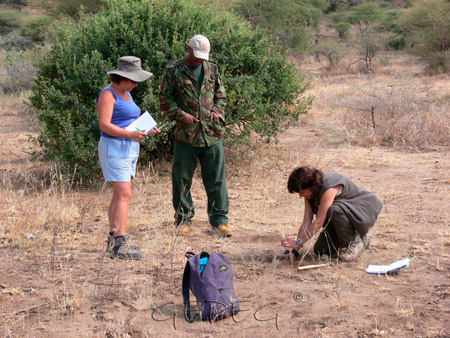

 The Olduvai Gorge, in northern Tanzania, is one of the most relevant paleoanthropological sites, since it has an important record of vertebrate fossils, including remains of hominids and lithic industry from Plio-Pleistocene and Pleistocene deposits. The work of paleoenvironmental reconstruction and vegetation has been carried out since 2001, within the framework of the Olduvai Landscape Paleoanthropology Project (OLAPP). The reconstruction of the vegetation and the paleo-landscape is based on a study of the paleoanthropological levels from the analysis of fossilized phytoliths and macro-plants and their comparison with the study of modern ecosystems present in the same area and that have conditions similar to those that would exist in the Olduvai Gorge during the period treated. The modern zones studied are the Ngorongoro Crater, Lake Manyara, Masek Lakes, Lake Ndutu, Lake Eyasi and Serengeti National Park. The results obtained to date have allowed the reconstruction of different emblematic localities of the Olduvai Gorge located in the western margin of the ancient paleolake, such as FLK, HWK or DK at the contemporary levels to which they recovered. the remains of Paranthropus boisei and Homo habilis (Bed I and Lower Bed II) As a continuation of the work carried out to date, we have recently started a new study focused on the same levels but corresponding to the eastern margin of the ancient paleolago, such as Loc. 66. On the other hand, we will shortly start studying the Acheulian levels (Beds III and IV) of the same Olduvai Gorge. This last part of the work will be carried out as part of the Olduvai Geochronology Project (OGAP) directed by Ignacio de la Torre (University College of London).
The Olduvai Gorge, in northern Tanzania, is one of the most relevant paleoanthropological sites, since it has an important record of vertebrate fossils, including remains of hominids and lithic industry from Plio-Pleistocene and Pleistocene deposits. The work of paleoenvironmental reconstruction and vegetation has been carried out since 2001, within the framework of the Olduvai Landscape Paleoanthropology Project (OLAPP). The reconstruction of the vegetation and the paleo-landscape is based on a study of the paleoanthropological levels from the analysis of fossilized phytoliths and macro-plants and their comparison with the study of modern ecosystems present in the same area and that have conditions similar to those that would exist in the Olduvai Gorge during the period treated. The modern zones studied are the Ngorongoro Crater, Lake Manyara, Masek Lakes, Lake Ndutu, Lake Eyasi and Serengeti National Park. The results obtained to date have allowed the reconstruction of different emblematic localities of the Olduvai Gorge located in the western margin of the ancient paleolake, such as FLK, HWK or DK at the contemporary levels to which they recovered. the remains of Paranthropus boisei and Homo habilis (Bed I and Lower Bed II) As a continuation of the work carried out to date, we have recently started a new study focused on the same levels but corresponding to the eastern margin of the ancient paleolago, such as Loc. 66. On the other hand, we will shortly start studying the Acheulian levels (Beds III and IV) of the same Olduvai Gorge. This last part of the work will be carried out as part of the Olduvai Geochronology Project (OGAP) directed by Ignacio de la Torre (University College of London).
ALBERT, R.M., 2015, Anthropocene and early human behaviour, The Holocene Journal 25(10), 1542-1552.
ALBERT, R.M. y BAMFORD, M.K., 2012, Vegetation during uppermost Bed I and deposition of Tuff IF at Olduvai Gorge, Tanzania, based on phytoliths and plant remains. Special issue: Fifty years after Zinjanthropus: Landscape Paleoanthropology of Plio-Pleistocene Olduvai Gorge, Tanzania, Journal of Human Evolution 63, 342-350.
ALBERT, R.M., BAMFORD, M.K. y CABANES, D., 2006, Taphonomy of phytoliths and macroplants in different soils from Olduvai Gorge (Tanzania) and the application to Plio-Pleistocene palaeoanthropological samples, Quaternary International 148, 78- 94.
ALBERT, R.M., BAMFORD, M.K. y CABANES, D., 2009, Palaeoecological significance of palms at Olduvai Gorge, Tanzania based on phytolith remains, Quaternary International 193, 41- 48.
ALBERT, R.M., BAMFORD, M.K., STANISTREET, I.G., STOLLHOFEN, H., RIVERA-RONDÓN, C. y RODRÍGUEZ-CINTAS, A., 2015, Vegetation landscape at DK locality, Olduvai Gorge, Tanzania, Palaeogeography, Palaeoclimatology, Palaeoecology 426, 34-45.
BAMFORD, M.K., ALBERT, R.M. y CABANES, D., 2006, Plio-Pleistocene macroplant fossil remains and phytoliths from Lowermost Bed II in the eastern paleolake margin of Olduvai Gorge, Tanzania, Quaternary International 148, 95-112.
BAMFORD, M.K., STANISTREET, I.G., STOLLHOFEN, H. y ALBERT, R.M., 2008, Late Pliocene grassland from Olduvai Gorge, Tanzania, Palaeogeography, Palaeoclimatology, Palaeoecology 257, 280-296.



